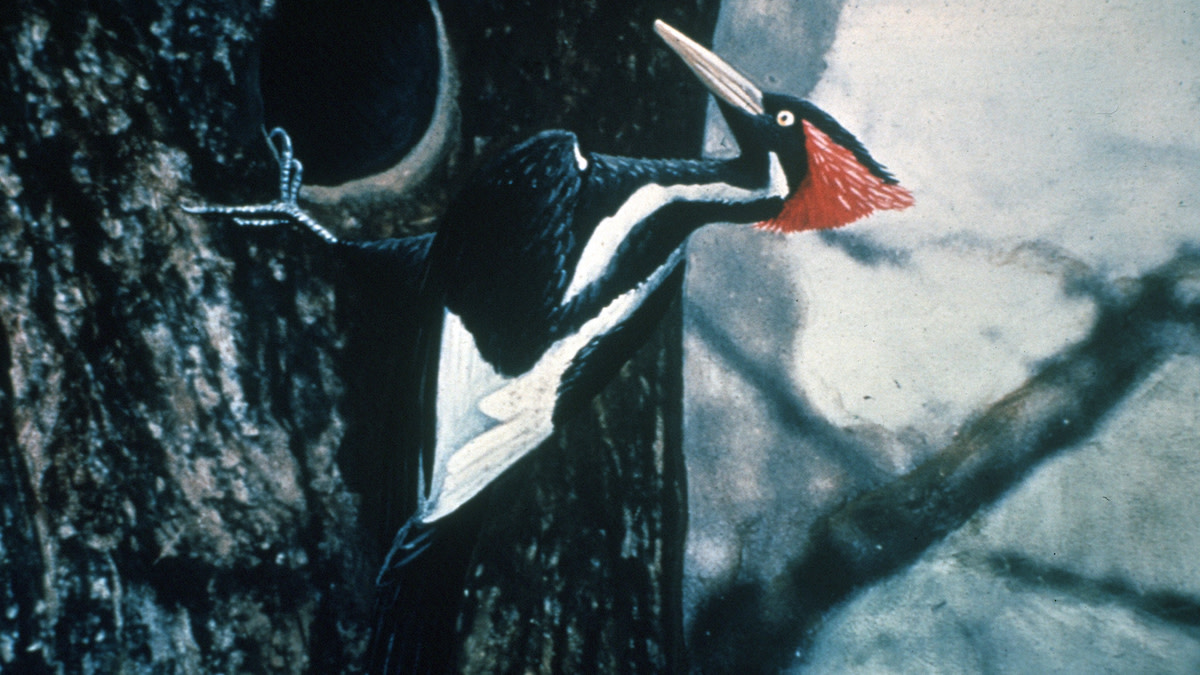
In October of last year, the U.S. Fish and Wildlife Service declared that 23 species of birds, mussels, bats, and fish had gone extinct. One of those species, the ivory-billed woodpecker, had been on the Endangered Species List since 1967 but hadn’t been officially seen since 1944.
The key word here is “officially.” Lots of people claimed to have seen one since 1944, but lots of people also claim to have seen black mountain lions in Arkansas (sorry, Clay). The Ivory-billed woodpecker suffered from deforestation and overhunting in the 1800s, and only very small numbers survived into the 20th century. Lacking enough hard evidence that any individuals existed in 2021, the USFWS determined that the ivory-billed woodpecker had indeed gone extinct.
But that may not be the end of the story. In a new research paper that has yet to be peer-reviewed, a team of biologists claim to have documented photographic evidence that ivory-billed woodpeckers still live in an undisclosed location in Louisiana, like feathery CIA agents with a taste for gumbo.
A nine-year search from 2012 to 2021 yielded photographs and videos that the team collected using trail cameras and a drone. Researchers also claim to have seen and heard the bird on numerous occasions, though they do not submit those sightings as official evidence in their paper.
To my eyes, the photographs aren’t as conclusive as I would have hoped. Despite how far photographic technology has come in the last few years, the images are grainy and appear to be shot from a long distance. It reminds me of trying to count the points on a buck’s rack from fuzzy trail cam footage.
To help me decipher these photos, I reached out to the paper’s lead researcher, Dr. Steven C. Latta. I asked him why his team believes they captured ivory-billed woodpeckers and not the similar-looking-but-much-more-common pileated woodpecker.
Dr. Latta told me that there are a few important points to keep in mind about these photos. First, even though it’s hard to tell, the photos do show the ivory-billed woodpecker’s distinctive white “saddle” that forms when the bird’s wings are closed against its back. You can also see the bird’s long neck and foot placement, which Dr. Latta says are distinctive of the ivory-billed as opposed to the pileated.
Latta also pointed out that the photos clearly show a group of three woodpeckers foraging together. Pileated woodpeckers rarely forage even in pairs and are fierce defenders of their territory. The fact that the team captured three large woodpeckers foraging on the same tree strongly suggests that the birds are ivory-billed.
The ivory-billed woodpecker saga goes to show how difficult, if not impossible, it can be to prove beyond doubt that a species has gone extinct. The world is a big place, and despite the illusion that humans control it, there are just too many places for a little bird or mouse or lizard to hide.
Latta and his team offer a few explanations as to why the ivory-billed woodpecker has been so tough to track down. The researchers point out that the species occupies some of the most difficult-to-reach mature bottomland forest habitat in the U.S. The birds live within a large home range up to four miles in diameter and eat insects from dead and dying trees that do not last for long periods of time. These factors help explain why the birds aren’t often seen at the same place twice and why scientists have such a difficult time finding them on purpose.
And if you believe in imprinted behavior, the ivory-bills were hunted persistently, and the intensity in which they were hunted actually increased when it was known that their numbers were dwindling. The scarcity of the bird drove demand–only the best and most persistent hunters could get close to them. If they do in fact exist in this Louisiana swamp, these birds are the descendants of birds that became so wary of humans and so good at avoiding them that they were, in fact, believed to be extinct.
So, next time you’re wandering through the bottomlands of Louisiana, keep your eyes—and ears—peeled. Here’s what you’re listening for.
For more conservation news and dope animal facts, check out Cal’s Week in Review. New episodes drop every Sunday.
Feature image via Wikicommons.





